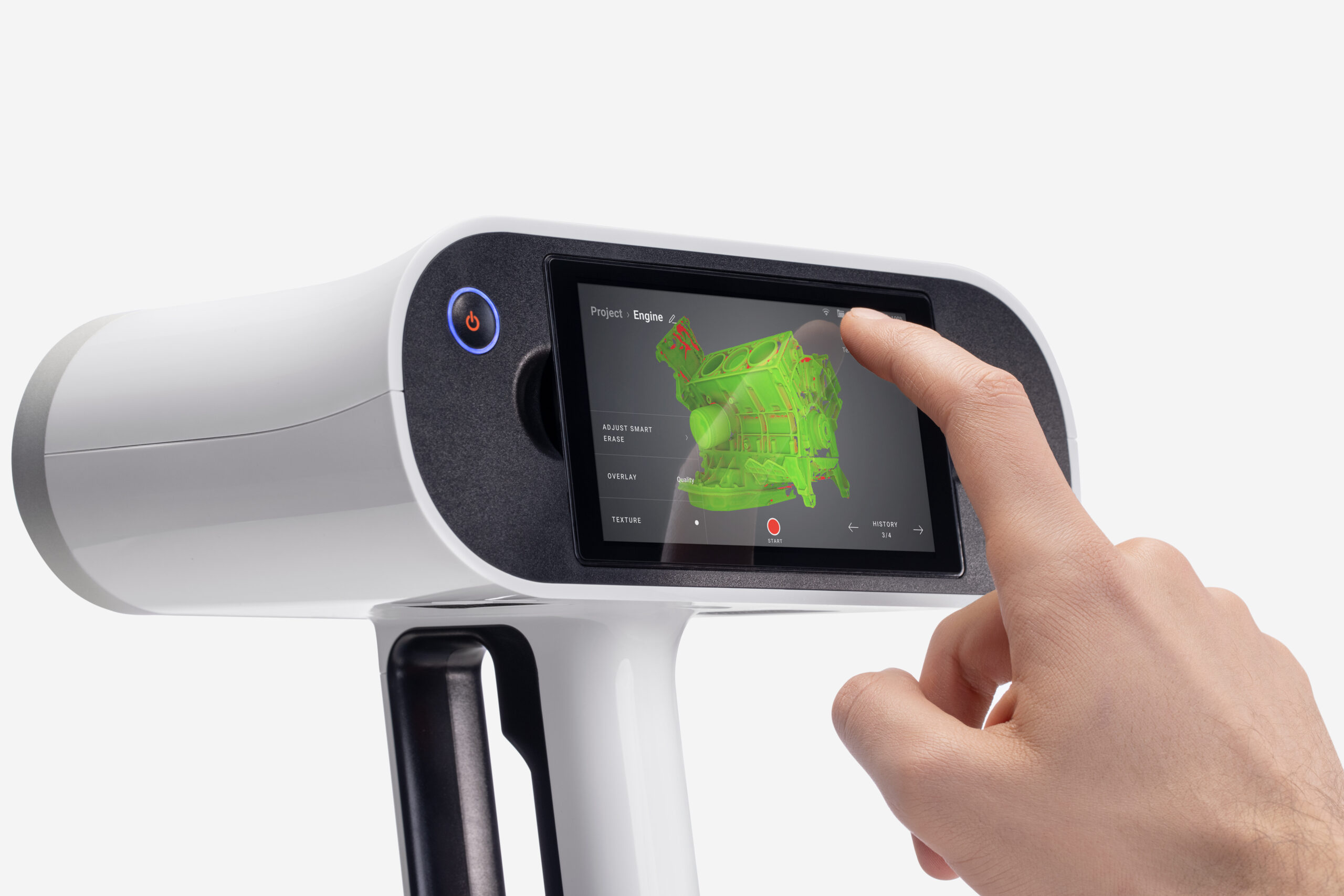In the rapidly evolving world of 3D design and manufacturing, having the ability to translate real-world objects into digital models is game-changing. This process, known as 3D scanning, bridges the gap between the physical and digital realms, allowing designers, engineers, and manufacturers to create precise, highly detailed models that can be further manipulated, analyzed, or reproduced through the use of reconstruction technology.
This technology has become increasingly important in industries such as aerospace, electric vehicles, and medical devices, where measurement accuracy and speed are critical for quality assurance. With the added feature of HD Mode, professional scanners can now offer even higher resolution and faster scanning, making the process even more efficient and accurate.
Among the top tools in this field, Artec 3D scanners stand out for their accuracy, ease of use, and versatility. But how exactly does an Artec 3D scanner work? Let’s dive into the process that takes you from IRL (in real life) to STL.
The Basics of 3D Scanning
At its core, 3D scanning is about capturing the shape and appearance of an object. Unlike traditional photography, which captures flat, 2D images, a scanner collects data from multiple angles to construct a complete three-dimensional model.
An Artec 3D scanner works by projecting a pattern of light onto the object. This light bounces back to the scanner’s sensors, which measure the distance from the scanner to the object’s surface at every point the light touches. By compiling this information, the scanner creates a digital “point cloud”—a collection of data points in space that represents the object’s shape.
Some of our best scanners, such as the professional Artec Eva and the affordable Eva Lite, are fast, versatile, and accurate, easily capturing scan data for small and medium-sized objects. The Eva and Eva Lite, with their ability to capture 16 frames per second and a 536 x 371mm capture window, are great options for quickly and easily digitizing large objects. Additionally, scanners like the Artec Leo and Space Spider have a touchscreen and intuitive UI for easy use and navigation during the scanning process, making them ideal for CGI or archival applications.
Types of 3D Scanners
There are several types of scanners, each with its own advantages:
- Laser Scanners: These use laser beams to scan the object. They are highly accurate and are often used for detailed inspections and reverse engineering.
- Structured Light Scanners: Artec 3D scanners fall into this category. They project a pattern of light onto the object and use cameras to capture the deformation of the pattern as it wraps around the object’s surface. This method is fast and can capture intricate details.
- Photogrammetry: This method involves taking multiple photographs from different angles and using software to stitch them together into a digital model. While less precise, it’s a cost-effective option for larger objects or environments.
The Artec 3D Advantage
Artec 3D scanners are renowned for their ability to capture objects with high accuracy and speed. Here’s why they stand out:
- No Need for Targets: Unlike some other scanners, Artec 3D scanners don’t require physical targets or markers on the object being scanned. This makes the scanning process quicker and more flexible.
- Portability: Artec 3D scanners are lightweight and portable, allowing for on-site scanning without the need for a dedicated scanning environment.
- Real-Time Scanning: The scanners provide immediate feedback, displaying the scanned object in real-time. This feature allows users to ensure they have captured all necessary details before finishing the scan.
- Ease of Use: With user-friendly interfaces and straightforward processes, Artec 3D scanners are accessible even to those new to scanning technology.
From Scan to STL
Once the physical scanning process is complete, the data collected by your Artec 3D scanner is processed into a digital model. This involves converting the point cloud into a mesh, a network of vertices, edges, and faces that define the object’s shape. The resulting mesh is then exported as an STL file, a format commonly used in 3D printing and CAD software.
From there, you can optimize the size of your final file by reducing the number of polygons from millions to thousands while maintaining the high quality of the mesh. Then, the STL file can be saved in a designated folder on an external USB drive for easy access and organization.
Now, your new STL file can be edited, analyzed, or used directly. From reverse engineering to creating custom parts for manufacturing, this seamless transition from the physical to the digital world highlights the incredible potential of scanning technology.
Applications of 3D Scanning
The applications of 3D scanning are vast and varied. Here are a few examples:
- Reverse Engineering: Capturing the exact dimensions of an existing part to create a digital model for reproduction or modification.
- Quality Control: Comparing the scanned object to its original CAD model to identify any deviations in production.
- Medical Applications: Creating custom prosthetics or implants based on a patient’s unique anatomy.
- Cultural Heritage: Preserving historical artifacts by creating digital replicas that can be studied without risk of damage.
The Future of 3D Scanning
As scanning technology continues to advance, we can expect even more accurate and accessible tools to emerge. Whether you’re a designer looking to digitize your ideas or a manufacturer aiming to streamline your production process, scanners like those from Artec are invaluable tools in the modern digital toolkit.
In conclusion, the journey from IRL to STL is one of precision, innovation, and endless possibilities. With a Artec 3D scanner like the Artec Space Spider or Artec Ray, using the advanced software of Artec Studio, you can capture the world around you in digital form, opening new avenues for creativity and production. So, whether you’re scanning for reverse engineering, quality control, or simply for the love of design, Artec 3D scanners like the Space Spider and Artec Ray, along with the powerful software of Artec Studio, are your gateway to the future of scanning and data collection.
Please fill the form and we will contact you soon
FAQ
How user-friendly is an Artec 3D scanner for those new to scanning technology?
Artec 3D scanners are known for their user-friendly interface, making them ideal for beginners in scanning technology. With intuitive software and simple calibration processes, users can quickly grasp the basics and start creating detailed scans with ease.
What are the key advantages of using Artec 3D scanners?
The key advantages of using Artec 3D scanners lie in their user-friendly interface, high precision, and ability to capture intricate details. Whether you are preserving cultural heritage or enhancing your design process, Artec scanners provide a seamless experience for beginners and professionals alike. Their user-friendly interface and straightforward calibration process makes them a perfect tool for those starting on their scanning journey. With intuitive software at your fingertips, creating detailed scans becomes an effortless task, allowing users to explore and innovate with ease.
What types of materials can an Artec 3D scanner capture?
Artec 3D scanners are versatile and can capture a wide range of materials, including plastics, metals, organic materials, and even reflective surfaces with high precision.
Is training required to use an Artec 3D scanner effectively?
While basic tutorials can help in getting started quickly, Artec 3D scanners are designed with user-friendliness in mind, allowing users to learn and master the scanning process relatively easily without extensive training.
How can Artec 3D scanners contribute to preserving cultural heritage?
Artec 3D scanners help preserve historical artifacts by creating digital replicas that can be studied without risking damage to the original pieces. Artec 3D scanners play a crucial role in preserving cultural heritage by digitally capturing historical artifacts. These digital replicas allow researchers, historians, and the public to study and appreciate these treasures without handling the delicate originals, thus ensuring their long-term preservation for future generations.














